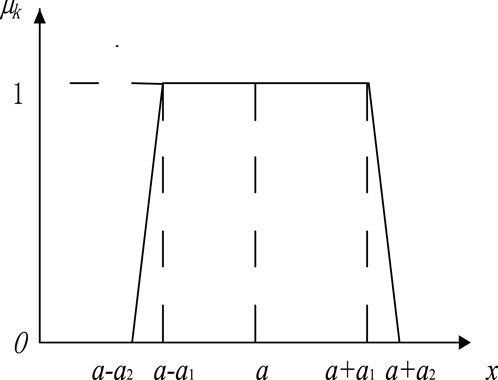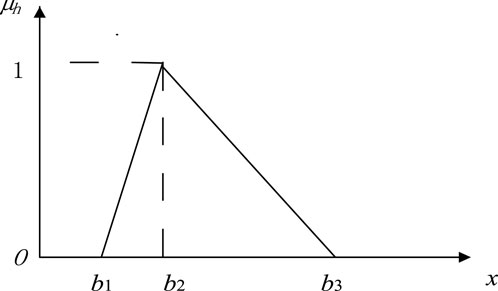- 1School of Architecture and Civil Engineering, Qiqihar University, Qiqihar, China
- 2School of Aerospace and Civil Engineering, Harbin Engineering University, Harbin, China
In this paper, the fuzzy scattering problem with semicircular depressions on the boundary of a band-shaped elastic plate with steady SH guided wave incident is studied and an analytical solution is given. First, the SH guided wave is constructed by the guided wave expansion method, and then the scattered wave satisfying the free condition of the boundary stress of the strip domain is constructed by the cumulative mirror method. Finally, a definite solution equation is obtained based on the fact that the shear stress at the edge of the semi-circular recessed hole is zero. In this paper, the ambiguity of the number of waves and the width of the bands is taken into account. In order to avoid the irreversibility of interval algorithm and the difficulty of solving non-linear equations, the membership function of fuzzy quantity is segmented to make the membership degree and fuzzy quantity correspond respectively. A deterministic problem that translates into piecewise processing. Two numerical examples are given to examine the changes in fuzzy response of different numbers of fuzzy waves and fuzzy thicknesses to the dynamic stress concentration factor of the hoop at the collapse limit.
1 Introduction
The scattering theory of elastic waves is widely used in the fields of earthquake engineering, ocean engineering and geological exploration. The research and application of elastic wave scattering are very extensive, and rich results have been achieved. For the study of elastic wave scattering problems, several parameters are uncertain. This is due to the ambiguity of its own objective attributes, the approximate processing of mathematical modeling, and the use of random parameters as deterministic parameters. Since the American cybernetics expert Professor Zadeh proposed fuzzy sets in 1965, the research direction of fuzzy mathematics has become more extensive, such as fuzzy reliability, fuzzy control, fuzzy optimization, fuzzy calculus equations and so on. Tong et al. [1] investigated the adaptive fuzzy output-feedback backstepping control design problem for uncertain strict-feedback non-linear systems in the presence of unknown virtual and actual control gain functions and immeasurable states. Shi et al. [2] proposed the issue of the reliable asynchronous sampled-data filtering of Takagi-Sugeno (T-S) fuzzy delayed neural networks with stochastic intermittent faults, randomly occurring time-varying parameter uncertainties and controller gain fluctuation. Zhao et al. [3] solved the problem of asymptotic tracking control for a class of uncertain switched non-linear systems under fuzzy approximation framework. Shi et al. [4] dealt with the non-fragile memory filtering issue of T-S fuzzy delayed neural networks with randomly occurring time-varying parameter uncertainties and variable sampling rates. Liu et al. [5] proposed the concept of q-rung orthopair fuzzy sets (q-ROFSs) to be able to describe more complex fuzzy uncertainty information effectively. Sun et al. [6] researched the issue of fuzzy adaptive control for a class of strict-feedback non-linear systems with non-affine nonlinear faults. Hu et al. [7] explored the performance of fuzzy system-based medical image processing for predicting the brain disease. Zhu et al. [8] investigated the event-triggered control problem for stochastic non-linear systems with unmeasured states and unknown backlash-like hysteresis. Lin et al. [9] proposed a novel picture fuzzy multi-criteria decision making (MCDM) model to solve the site selection problem for car sharing stations. Zhang et al. [10] studied the fault detection problem for continuous-time fuzzy semi-Markov jump systems (FSMJSs) by employing an interval type-2 (IT2) fuzzy approach. Wang et al. [11] presented a fault-tolerant tracking control strategy for Takagi-Sugeno fuzzy model-based non-linear systems which combines integral sliding mode control with adaptive control technique. Garg H et al. [12] introduced a novel multi-attribute decision making (MADM) method under interval-valued intuitionistic fuzzy (IVIF) set environment by integrating a Technique for Order Preference by Similarity to Ideal Solution (TOPSIS) method. Pan et al. [13] developed a novel risk analysis approach by merging interval-valued fuzzy sets (IVFSs), improved Dempster-Shafer (D-S) evidence theory, and fuzzy Bayesian networks (BNs), acting as a systematic decision support approach for safety insurance for the entire life cycle of a complex system under uncertainty. In other numerical applications, spectral elemental methods are also effectively applied by researchers [14-15]. Mahariq I et al. [16] explored the on-resonance and off-resonance optical response of dielectric cylinders excited by normal incident plane waves. Mahariq I et al. [17] also studied photonic nanojets resulting from corrugated cylinders (with irregular boundaries) under normally incident plane-wave illumination.
SH waves are the most fundamental elastic waves, propagating in a direction perpendicular to the direction of vibration. The SH wave has only one inverse plane vibration displacement (out-of-plane displacement). Compared to P and SV waves, SH waves have the simplest elastodynamic behaviour. For elastic dynamics problems with complex initial boundary conditions, P and SV waves can be difficult to find solutions for. For SH waves, however, such problems can be easily solved to obtain further analytical solutions. There are a lot of ambiguity factors in the elastic wave scattering problem, such as seismic intensity, wave speed, medium shear modulus, medium density, amplitude and frequency of incident waves, etc., all of which are typical ambiguities with randomness and ambiguity. In this paper, the ambiguity of the number of waves and plate thickness ambiguity of SH guided wave scattering are studied for the semicircular depression on the boundary of the band-shaped elastic plate, and the membership function is segmented so that the ambiguity and the membership function correspond respectively. This method can avoid the appearance of interval numbers and combine the decomposition theorem of fuzzy numbers well. In this paper, a new theoretical method is given to deal with fuzzy dynamics knowledge, and the curve of dynamic stress concentration factor of semicircular sag boundary with membership degree of fuzzy quantity is discussed in detail, and a valuable reference conclusion for practical engineering is obtained.
2 Theoretical model and analysis
2.1 Theoretical model
In this paper, the classical model in the reference [18] is used as an example to further illustrate the use of fuzzy mathematics in solving the scattering problem for defects in thin plates. As shown in Figure 1, the thickness of the infinitely long strip-shaped domain is h, the upper boundary is
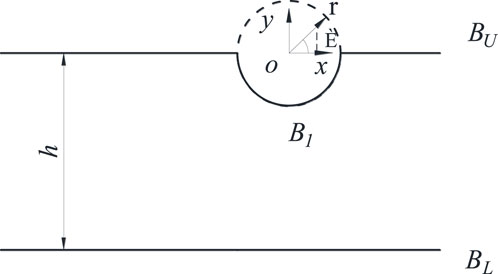
FIGURE 1. Theoretical model of steady-state scattering of SH waves by semi-cylindrical depressions in elastic ribbon domains.
2.2 Control equation
According to the theoretical model shown in Figure 1, the control equations satisfying the upper and lower boundary stress freedom can be obtained. According to reference [19], the control equation for the anti-plane dynamics problem can be obtained. The governing equation of the elasto-dynamic inverse plane problem is the scalar wave Eq. 1:
In the formula:
Where:
2.3 Incident wave
Establish a global coordinate system at any point of the upper boundary
Using the superposition method to superimpose the guided waves of each order, all the displacement waves in the strip-shaped medium satisfying the stress freedom of the upper and lower boundaries can be obtained:
In this chapter, the steady-state SH wave is discussed, and the time harmonic factor
2.4 Scattered waves
Under the action of incident SH waves, the concave will produce scattered waves. By using the method of repeated mirror image, the semi-cylindrical depression
The scattered wave
Repeating this, the displacements of the P-th mirror scattered waves are
In the above formula:
Using the superposition method, the scattered waves obtained by each mirror image are accumulated together, and the displacement of the scattered waves generated by the circular hole
2.5 Definite solution conditions
The incident wave and scattered wave constructed according to the above method have already satisfied the condition that the shear stress at the boundary
2.6 Dynamic stress concentration factor
Under the action of steady-state SH wave, the dynamic stress concentration factor characterizes the degree of dynamic stress concentration. Define Eq. 29 as the dynamic stress concentration factor of the recessed edge.
Where:
3 Examples and analysis
3.1 Analysis of fuzzy example 1
There are several fuzzy parameters in this problem including wave amplitude, frequency, and wave speed in the plane of perturbation which may all be fuzzy numbers. As can be seen from reference [20], the different affiliation curves are treated according to trapezoidal segments. It is assumed that the ambiguity membership function of the wavenumber is
The related membership relationship can be expressed as:
The analysis only needs to consider a range of
When
When
When
Let a = 2, a2 = 1.5, a1 = 1, r = 1. By considering the different thicknesses
Figure 3 shows the distribution of the hoop dynamic stress concentration factor of the semicircular depression in different sections when the thickness of the belt domain is
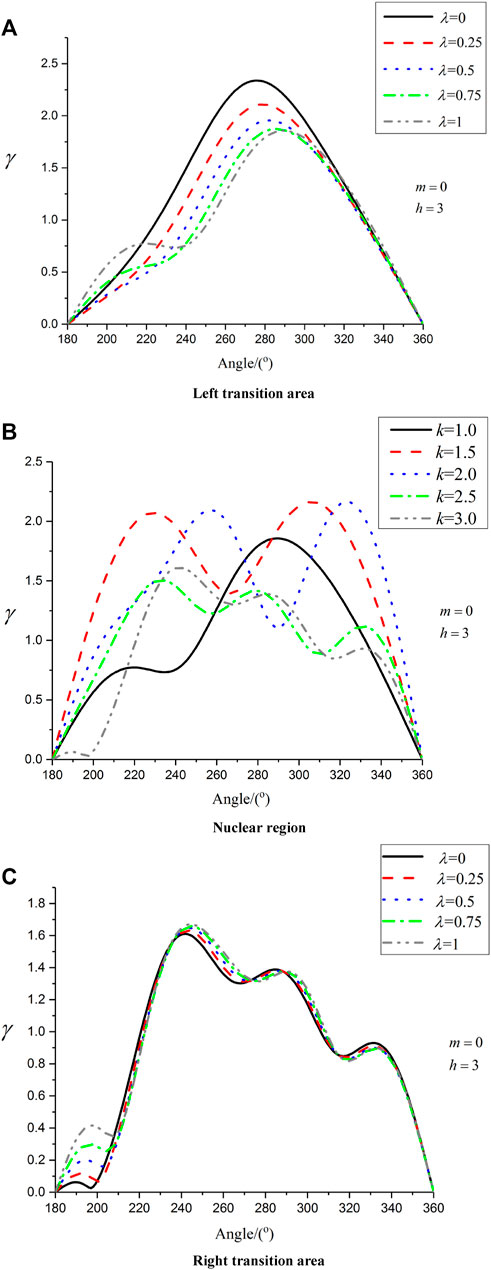
FIGURE 3. Distribution of hoop dynamic stress concentration factor of semi-circular depression when the thickness of the ribbon domain is
As can be seen from Figure 4, the left transition area of the membership function curve is a low wave number area, the maximum value of dynamic stress concentration factor appears on the membership degree
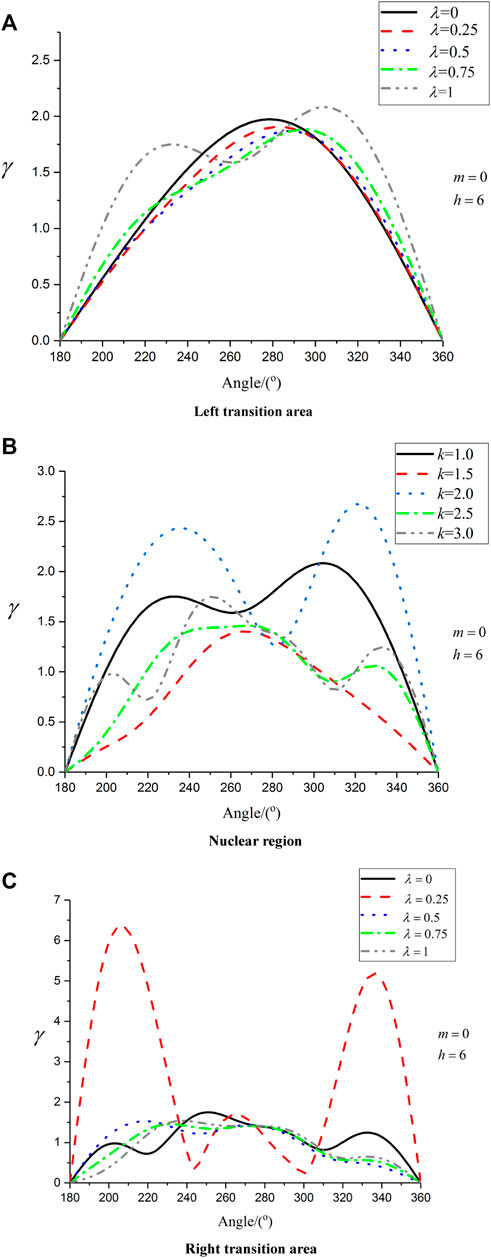
FIGURE 4. Distribution of hoop dynamic stress concentration factor of semi-circular depression when the thickness of the ribbon domain is
From Figure 5, the thickness
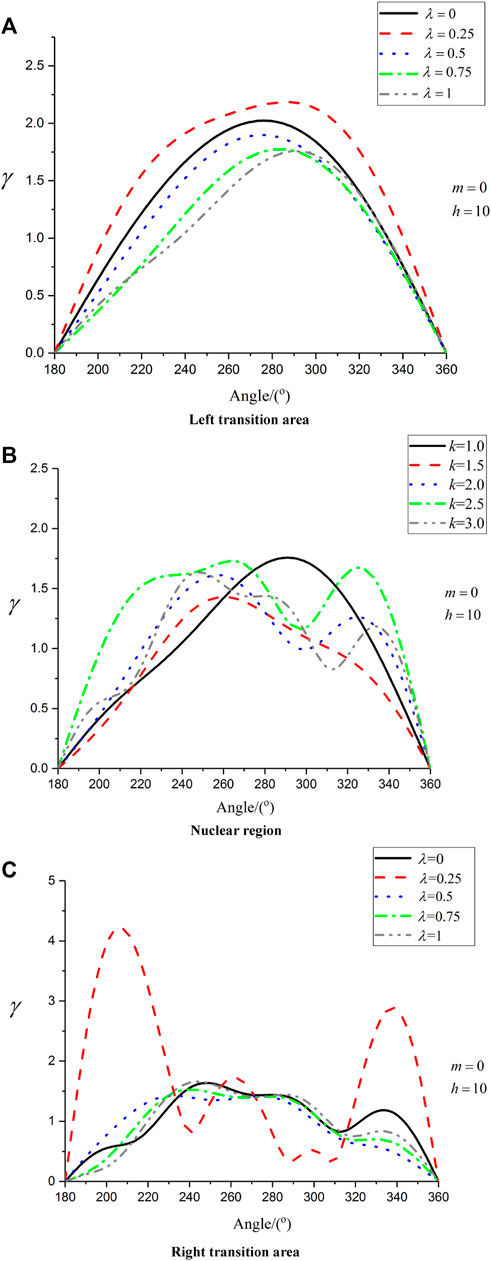
FIGURE 5. Distribution of hoop dynamic stress concentration factor of semi-circular depression when the thickness of the ribbon domain is
It can be seen from Figure 6 that the dynamic stress concentration factor in the left transition area of the membership function curve is significantly higher than that in the core area and the right transition area, and the curve of the stress concentration factor in the left transition area changes gently. With the increase of wave number, the curve has obvious oscillation, and the change is more obvious in the right transition region (high wave number region). The maximum value of the wave crest in the left transition area appears at the position of membership degree
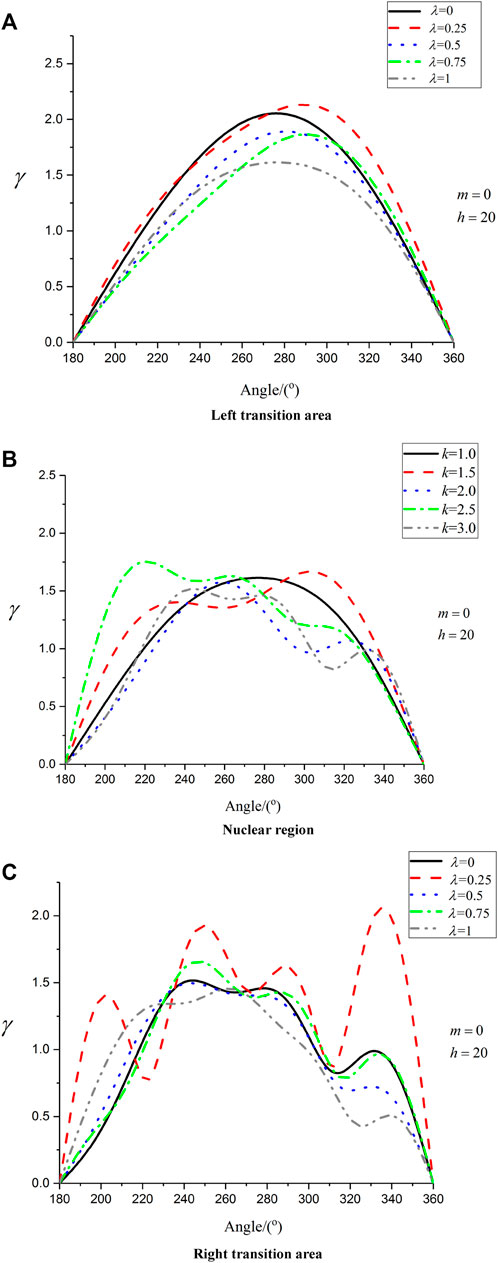
FIGURE 6. Distribution of hoop dynamic stress concentration factor of semi-circular depression when the thickness of the ribbon domain is
3.2 Analysis of fuzzy example 2
As can be seen from reference [21], the different affiliation curves are treated according to triangular segments. Assuming that the fuzzy membership function of the thickness h of the elastic plate in the belt domain is
In this analysis, only
It can be seen from Figure 8 that when
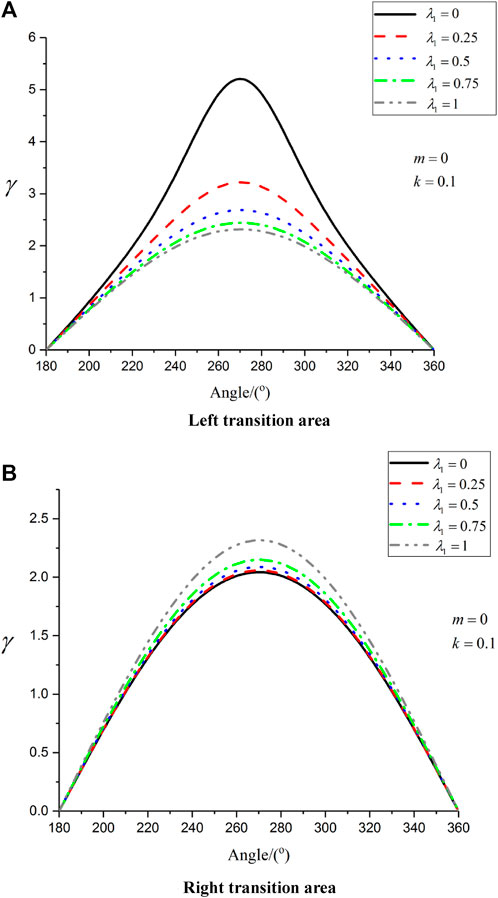
FIGURE 8. Distribution of hoop dynamic stress concentration factor with
It can be seen from Figure 9 that when
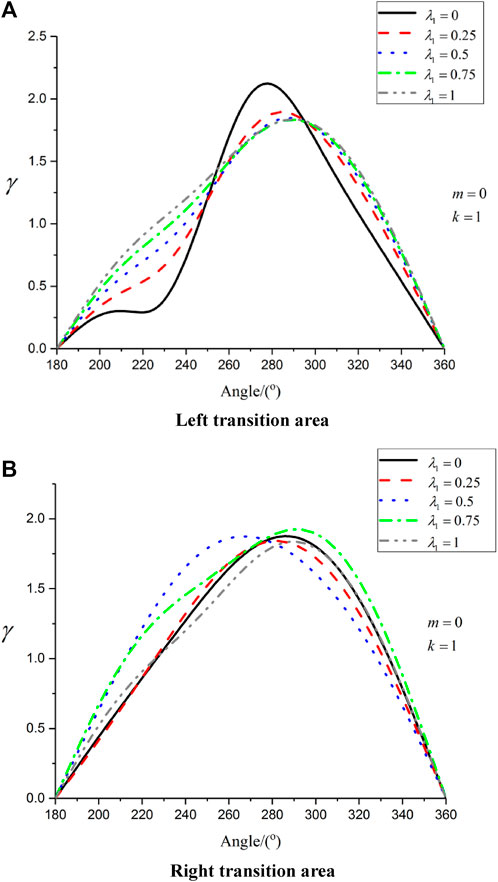
FIGURE 9. Distribution of hoop dynamic stress concentration factor with
It can be seen from Figure 10 that when
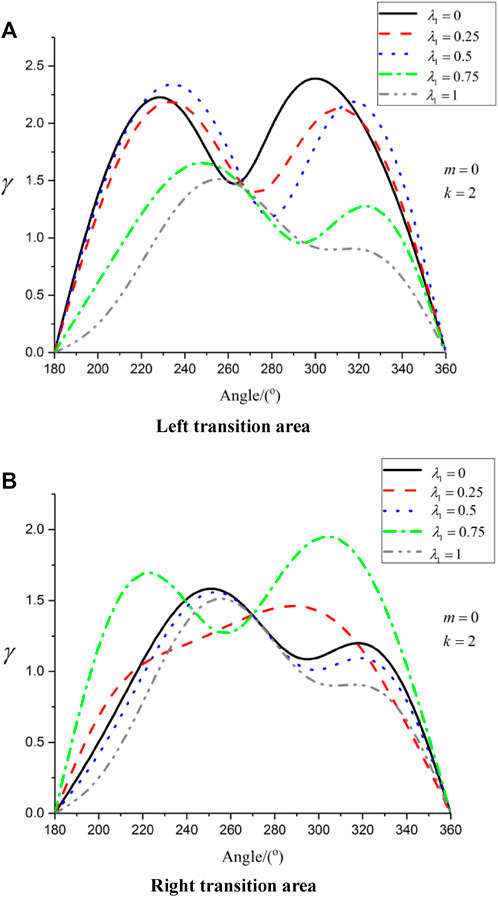
FIGURE 10. Distribution of hoop dynamic stress concentration factor with
4 Conclusion
The solution to the elastic wave scattering problem is often a non-linear function of various parameters, and there is no mature and unified method to obtain the explicit expression of the fuzzy parameters. Even if the inverse function is reached, it is mostly a multi-valued function. Various parameters are often ambiguous, and the membership function of fuzzy response is not always solved by using the membership function of known fuzzy parameters, and the irreversibility of interval algorithm also brings many difficulties in solving fuzzy response problem. In this paper, the correspondence between the subordinate function and the fuzzy quantity pairs is exploited to segment the subordinate function so that each segment corresponds to the fuzzy quantity. This method can effectively avoid the process of interval calculation and does not violate the decomposition process of fuzzy numbers. Two different affiliation curves are given for the trapezoidal and triangular distributions. We solve the multi-source fuzzy scattering problem for wave number and band shape domain thickness, respectively. The calculation example results show the feasibility of the algorithm, and provide theoretical basis and reference value for the application of fuzzy mathematics to earthquake engineering.
Data availability statement
The raw data supporting the conclusion of this article will be made available by the authors, without undue reservation.
Author contributions
EQ and HQ contributed to the conception and design of the study. EQ performed the statistical analysis and wrote the first draft of the manuscript. JG wrote sections of the manuscript. All authors contributed to manuscript revision, read, and approved the submitted version.
Funding
This work was supported by the Heilongjiang Provincial Undergraduate Universities Basic Scientific Research Business Young Innovative Talents Project (145209209).
Conflict of interest
The authors declare that the research was conducted in the absence of any commercial or financial relationships that could be construed as a potential conflict of interest.
Publisher’s note
All claims expressed in this article are solely those of the authors and do not necessarily represent those of their affiliated organizations, or those of the publisher, the editors and the reviewers. Any product that may be evaluated in this article, or claim that may be made by its manufacturer, is not guaranteed or endorsed by the publisher.
References
1. Tong S, Min X, Li Y. Observer-based adaptive fuzzy tracking control for strict-feedback nonlinear systems with unknown control gain functions. IEEE Trans Cybernetics (2020) 50(9):3903–13. doi:10.1109/TCYB.2020.2977175
2. Shi K, Wang J, Tang Y, Zhong S. Reliable asynchronous sampled-data filtering of T–S fuzzy uncertain delayed neural networks with stochastic switched topologies. Fuzzy Sets Syst (2020) 381:1–25. doi:10.1016/j.fss.2018.11.017
3. Zhao X, Wang X, Ma L, Zong G. Fuzzy approximation based asymptotic tracking control for a class of uncertain switched nonlinear systems. IEEE Trans Fuzzy Syst (2019) 28(4):632–44. doi:10.1109/TFUZZ.2019.2912138
4. Shi K, Wang J, Zhong S, Tang Y, Cheng J. Non-fragile memory filtering of T-S fuzzy delayed neural networks based on switched fuzzy sampled-data control. Fuzzy Sets Syst (2020) 394:40–64. https://doi .org/10.1016/j.fss.2019.09.001.
5. Liu P, Chen SM, Wang P. Multiple-attribute group decision-making based on q-rung orthopair fuzzy power maclaurin symmetric mean operators. IEEE Trans Syst Man, Cybernetics: Syst (2018) 50(10):3741–16. doi:10.1109/TSMC.2018.2852948
6. Sun K, Liu L, Qiu J, et al. Fuzzy adaptive finite-time fault-tolerant control for strict-feedback nonlinear systems[J]. IEEE Trans Fuzzy Syst (2020) 29(4):786–96. doi:10.11009/TFUZZ.2020.2965890
7. Hu M, Zhong Y, Xie S, Lv H, Lv Z. Fuzzy system based medical image processing for brain disease prediction. Front Neurosci (2021) 15:714318. doi:10.3389/fnins.2021.714318
8. Zhu Z, Pan Y, Zhou Q, Lu C. Event-triggered adaptive fuzzy control for stochastic nonlinear systems with unmeasured states and unknown backlash-like hysteresis. IEEE Trans Fuzzy Syst (2020) 29(5):1273–83. doi:10.1109/TFUZZ.2020.2973950
9. Lin M, Huang C, Xu Z. MULTIMOORA based MCDM model for site selection of car sharing station under picture fuzzy environment. Sustain cities Soc (2020) 53:101873. doi:10.1016/j.scs.2019.101873
10. Zhang L, Lam HK, Sun Y, Liang H. fault detection for fuzzy semi-markov jump systems based on interval type-2 fuzzy approach. IEEE Trans Fuzzy Syst (2019) 28(10):2375–88. doi:10.1109/TFUZZ.2019.2936333
11. Wang Y, Jiang B, Wu ZG, Xie S, Peng Y. Adaptive sliding mode fault-tolerant fuzzy tracking control with application to unmanned marine vehicles. IEEE Trans Syst Man, Cybernetics: Syst (2020) 51(11):6691–700. doi:10.1109/TSMC.2020.2964808
12. Garg H, Kumar K. A novel exponential distance and its based TOPSIS method for interval-valued intuitionistic fuzzy sets using connection number of SPA theory. Artif Intelligence Rev (2020) 53(1):595–624. doi:10.1007/s10462-018-9668-5
13. Pan Y, Zhang L, Li ZW, Ding L. Improved fuzzy bayesian network-based risk analysis with interval-valued fuzzy sets and D–S evidence theory. IEEE Trans Fuzzy Syst (2019) 28(9):2063–77. doi:10.1109/TFUZZ.2019.2929024
14. Mahariq I, Giden IH, Alboon S, Fouad Aly WH, Youssef A, Kurt H. Investigation and analysis of acoustojets by spectral element method[J]. Mathematics (2022) 10(17):3415. https://www.mdpi.com/2227-7390/10/23/4516.
15. Mahariq I, Kuzuoğlu M, Tarman IH, Kurt H. Photonic nanojet analysis by spectral element method[J]. IEEE Photonics J. (2014) 6(5):1–14. doi:10.1109/JPHOT.2014.2361615
16. Mahariq I, Kurt H. On-and off-optical-resonance dynamics of dielectric microcylinders under plane wave illumination[J]. JOSA B (2015) 32(6):1022–1030. doi:10.1364/JOSAB.32.001022
17. Mahariq I, Astratov VN, Kurt H. Persistence of photonic nanojet formation under the deformation of circular boundary[J]. JOSA B (2016) 33(4):535–542. doi:10.1364/JOSAB.33.000535
18. Qu EX, Qi H, Guo J, Wang L. Dynamic response analysis of SH-guided waves in a strip-shaped elastic medium for a semi-cylindrical depression[J]. Arch. Appl. Mech. (2023) 93(3):1241–1258. doi:10.1007/s00419-022-02325-9
19. Liu D, Gai B, Tao G. Applications of the method of complex functions to dynamic stress concentrations[J]. Wave motion (1982) 4(3):293–304. doi:10.1016/0165-2125(82)90025-7
20. Shi WP, Fang SJ, Zhang CP, Yang HL. Fuzzy response of semicircular concave boundaries in half space to SH wave scattering [J]. Mech. strength (2011) 33(03):373–378. doi:10.16579/j.issn.1001.9669.2011.03.012
Keywords: semicircular depressions, fuzzy scattering, SH guided wave, membership function, fuzzy thicknesses
Citation: Qu E, Qi H, Guo J, Yuan S and Lv C (2023) Fuzzy response to SH guided-wave scattering by semicircular depressions on the boundary of a ribbon-shaped elastic plate. Front. Phys. 11:1169012. doi: 10.3389/fphy.2023.1169012
Received: 18 February 2023; Accepted: 10 April 2023;
Published: 10 May 2023.
Edited by:
Xiangpeng Xin, Liaocheng University, ChinaReviewed by:
Muhammad Mujtaba Shaikh, Mehran University of Engineering and Technology, PakistanIbrahim Mahariq (2 PhDs), American University of the Middle East, Kuwait
Copyright © 2023 Qu, Qi, Guo, Yuan and Lv. This is an open-access article distributed under the terms of the Creative Commons Attribution License (CC BY). The use, distribution or reproduction in other forums is permitted, provided the original author(s) and the copyright owner(s) are credited and that the original publication in this journal is cited, in accordance with accepted academic practice. No use, distribution or reproduction is permitted which does not comply with these terms.
*Correspondence: Enxiang Qu, MDMzMThAcXFocnUuZWR1LmNu
 Enxiang Qu
Enxiang Qu Hui Qi2
Hui Qi2